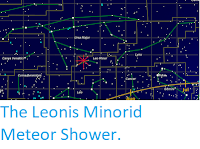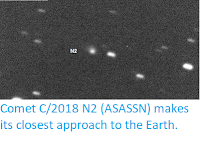Asteroid 2019 UE4 passed by the Earth at a distance of about 407 700
km (1.06 times the average distance between the Earth and the Moon, or
0.27% of the distance between the Earth and the Sun), slightly after 10.05 pm
GMT on Monday 21 October 2019. There was no danger of
the asteroid hitting us, though were it to do so it would not have
presented a significant threat. 2019 UE4 has an estimated
equivalent
diameter of 6-18m (i.e. it is estimated that a spherical object
with
the same volume would be 6-18 m in diameter), and an object of this
size
would be expected to explode in
an airburst (an explosion caused by superheating from friction with the
Earth's atmosphere, which is greater than that caused by simply
falling, due to the orbital momentum of the asteroid) in the atmosphere between 38 and 24 km above the ground, with only fragmentary material
reaching the Earth's surface.
The calculated orbit of 2019 UE4. JPL Small Body Database.
2019 UE4 was discovered on 23 October 2019 (two days after its closest approach to the Earth) by the Atlas MLO Telescope at Mauna Loa Observatory in Hawaii. The designation 2019 UE4 implies that the asteroid was the 101st object (object E4 -
in numbering asteroids the letters A-Z, excluding I, are assigned
numbers from 1 to 25, so that E4 = (24 x 4) + 5 = 101) discovered in the second half of October 2019 (period 2019 U).
2019 UE4 has a 573 day orbital period and an eccentric orbit
tilted at an angle of 1.05° to the plane of the Solar System, which
takes it from 0.80 AU from the Sun (i.e. 80% of he average distance at
which the Earth orbits the Sun) to 1.90 AU from the Sun (i.e. 190% of
the
average distance at which the Earth orbits the Sun, beyond the orbit of the planet Mars). It is therefore
classed as an
Apollo Group Asteroid (an asteroid that is on average further from the
Sun than the Earth, but which does get closer). This
means that 2019 UE3 occasionally comes close to the Earth, with the
last such encounter having happened in May 2016, and the next
predicted for May 2024. 2019 UE3 also has occasional close encounters
with the planet Venus, with the next close encounter predicted in December 2046, and Mars, which it last came close to in October 1987 and is predicted to pass again in November 2024.
See also...
Follow Sciency Thoughts on Facebook.







